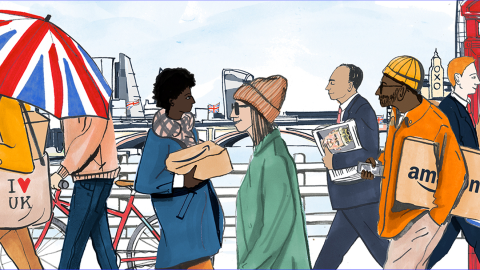It takes less than a minute in the presence of Anne Boden, CEO and founder of Starling Bank, to find yourself overwhelmed by her charisma and positive energy. A first impression that definitely helps realise how Anne got where she is – that is, at the head of one of the most innovative banks in the UK, one that she personally built from scratch. That’s right: at 50, with a background in IT and a long career within traditional banking under her belt (enriched by the occasional incursion in the insurance and fintech fields), Anne quit her position as Chief Operating Officer of Allied Irish Banks (AIB) to build what she envisioned as the bank of the future. The result is Starling Bank, a UK-based bank offering 100% mobile accounts and payment services as well as tools for developers.
What I was really afraid of was failure. Then I realised that if you fail at something simple you may be criticized, but nobody will really blame you for failing at something nearly impossible. So I chose to be audacious.
The idea for a radical new approach to banking
The first seed for what became Anne’s innovative vision dates back to 2008, when the financial crisis shook the universe of traditional banking. Something was broken in the system and needed fixing. Hungry for new ideas, in 2011 Anne took a sabbatical to start collaborating with tech startups, where she discovered a world of young professionals and lean teams that were quietly transforming people’s lives and the way they interacted with industries, services, and even with each other. However, this was a transformation that hadn’t touched the banking system, yet. “It was quite a shock,” she recalls. “I thought I knew everything about banking and technology, but here were people with much less experience than I had, who were using new, fast tools to build things consumers wanted. I also came across Amazon Web Services (AWS) for the first time, and I was intrigued by building applications for the cloud. When I ultimately joined AIB as a Chief Operating Officer to return the bank to profitability after the crisis, I brought these new technologies and processes with me. It was very fulfilling. By that time, though, I had reached the conclusion that customers had changed. They were buying things differently, shopping on Amazon, listening to music via streaming, interacting with each other on social media. Only banking had not evolved. This is why, in 2014, I quit my job to start a bank and serve customers in a new way. And people thought I was crazy!”

An audacious choice
Anne was in her fifties at that time. At an age when many people start thinking of their pension, she didn’t hesitate in reinventing herself. Why not, after all? “I had a successful career, but I still had the ambition to do something that had never been done before. After working for 30 years, I also had a certain amount of security and could afford taking time off to focus on a new project. What I was really afraid of was failure. Then I realised that if you fail at something simple you may be criticized, but nobody will really blame you for failing at something nearly impossible. So I chose to be audacious.”
The timing seemed right, and not only from Anne’s personal perspective. “Firstly, people had changed,” she explains. “Whilst the banks were trying to fix the problems of the past, people were experiencing different technologies in many parts of their lives. Secondly, the regulators had decided that banks had become too concentrated, and there was room for new players. Finally, it was now possible to develop new technologies without the investment that would have been required in the past. There was an opportunity to pull all those changes together and start something new.”
How to start a bank from scratch
But how does one actually build a bank? Where do you begin? “It’s a bit of a catch-22, as you have to raise money and you need a banking license, and it’s hard to get one without the other,” she laughs. Luckily, new regulations from 2013 had made it easier for new players to enter the scene, so Anne could get her project started. She estimated that setting everything up would require 300 million pounds, including all the costs to build the infrastructure: quite a bill. This is why she turned to AWS: “After we discovered all the services we could buy from Amazon, our estimate went down to one sixth of what it had been. AWS provided us with a resilient infrastructure that could grow as fast as our business needed in a ‘pay-as-you-go’ sort of way. Plus, they worked with us to devise creative solutions to satisfy the regulators’ demands for security standards: when we started, it wasn’t legally possible to build a bank in the cloud. By working step by step with the regulators and with AWS, it became not only possible, but real.”
“Most of all, if you want to build a bank you need people who believe in you,” Anne continues. “I spent a lot of time convincing people that it was possible to have a technology-based, smartphone-optimised bank built in the cloud. I was lucky to find a lot of support.” Family and friends helped Anne in their spare time, one of her cousins became her accountant when she couldn’t afford paying for one and some of her team mates worked for months without a salary to help bring her vision to life. “There were times when I thought we wouldn’t make it. In those moments, sometimes it is easier to carry on than to stop. Just when you’re thinking of giving up, you give yourself another day, and the following day something good will happen.”
For Starling, the turning point came when a single investor became fascinated with Anne’s vision and helped her raise 48 million. In 2016, Starling finally obtained its license, and Anne and her team celebrated the milestone with cupcakes and champagne. The bank opened its virtual doors in April 2017. “By now we offer a retail and a business account, and a real time interfaces into the payment schemes for other FinTech’s and government departments such as the Department of Work and Pension – we are the only provider of that service in the UK. And we are looking to expand in the rest of Europe in the near future.”
Say it out loud
Anne’s remarkable story may seem linear and driven by an unwavering sharp vision, but this is not exactly true. By her own admission, it took her a while to put a name to her ambition. She remembers the moment realisation dawned on her: “I was at a cocktail party, with a glass of prosecco in my hand. Somebody asked about my profession, and I replied ‘I’m starting a bank’. As the words came out of my mouth, I shocked myself. People don’t just start banks! The other person literally walked back, thinking I was crazy. But the more I said the words, the more used to them I got. And once I got used to them, it was a question of other people becoming used to the idea. For anybody who is changing a career, or starting a business: first you have to convince yourself of what you want. Then get used to asking people for help, and people will help you like they helped me deliver Starling.”











